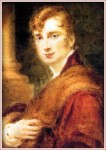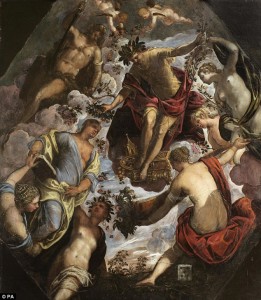 Adventurer, collector and early Egyptologist William John Bankes purchased a dramatic octagonal painting known as Apollo and the Muses in Italy in 1849 and sent it back to Kingston Lacy, his ancestral home in Dorset. He thought it was a Tintoretto, but although he had an excellent eye for art and antiquities, he wasn’t always right, and private commissions of Tintoretto paintings are extremely rare since most of his work was made for and remains in public buildings in Venice.
Adventurer, collector and early Egyptologist William John Bankes purchased a dramatic octagonal painting known as Apollo and the Muses in Italy in 1849 and sent it back to Kingston Lacy, his ancestral home in Dorset. He thought it was a Tintoretto, but although he had an excellent eye for art and antiquities, he wasn’t always right, and private commissions of Tintoretto paintings are extremely rare since most of his work was made for and remains in public buildings in Venice.
When the Bankes family gave Kingston Lacy to the National Trust in 1981, the painting was so filthy and encrusted with old darkened varnish that authentication was impossible. They didn’t have the funds then to have the painting expertly cleaned, so it remained in storage until today. The painting, all 9 by 8 feet of it, is on display again in the Kingston Lacy dining room after a £36,000 ($53,000) cleaning and restoration by the Hamilton Kerr Institute in Cambridge, and now that experts can actually see it, there is no doubt that it’s a Tintoretto, probably from the 1560s or 1570s.
The Hamilton Kerr Institute took X rays and infrared images of the painting which revealed Tintoretto’s distinctive style and brush strokes. They also showed various changes Tintoretto made to the figures, their clothing, their positions before deciding on a final version.
 The cleaning has raised a whole new bag of issues, however. For one thing, it’s now clear that it is not a painting of Apollo and the Muses, because there are 7 figures attending Apollo, not 9. For another thing, there are all kinds of symbols that are perplexing to our contemporary sensibility. That single die with five dots in the bottom right corner may have been part of 16th c. vernacular, but we have no idea what Tintoretto meant by it. Also what do the gold cup, dish, box and steeple beneath Apollo’s feet signify? And who are all those figures anyway? One of them is definitely Hercules wearing his characteristic lion skin, but what is he doing there?
The cleaning has raised a whole new bag of issues, however. For one thing, it’s now clear that it is not a painting of Apollo and the Muses, because there are 7 figures attending Apollo, not 9. For another thing, there are all kinds of symbols that are perplexing to our contemporary sensibility. That single die with five dots in the bottom right corner may have been part of 16th c. vernacular, but we have no idea what Tintoretto meant by it. Also what do the gold cup, dish, box and steeple beneath Apollo’s feet signify? And who are all those figures anyway? One of them is definitely Hercules wearing his characteristic lion skin, but what is he doing there?
The main figure might be Apollo, or it might be Hymen, the Greek god of marriage. The man draped in blue might be a poet who is being presented to his spouse, the rather pale lady – or he might not be. What is the die with the five dots, underneath the woman draped in red, all about? What is the significance of all the gold? That must be Hercules in the top left but who is everyone else? Is it, perhaps, Fortune, above the die?
In the meantime the painting, probably from the 1560s or 1570s, has been renamed as “Apollo (or Hymen) crowning a poet and giving him a spouse”, but Bradley said that was something like its fifth name in the last few months. “The name will probably have to change again. I would personally say it’s definitely Apollo but I’m not even sure he’s marrying someone – my boss and I are agreeing to differ on that.”
The x-ray and infrared analysis used to prove it is definitely the work of Tintoretto also throws up questions. Why, for example, did Tintoretto paint the possible poet as nearly naked before the blue robes were later added?
The National Trust is asking for help from the public in answering all the questions they have about this uniquely fabulous piece. If you have any ideas, tweet them at http://twitter.com/nationaltrust.
Meanwhile, here’s a neat graphic that highlights some of the questions art historians have about the piece.
If you are reading this anywhere else besides on www.thehistoryblog.com, it has been reprinted without author permission.